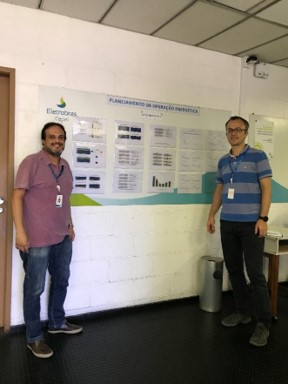
The contrasts between the hydropower systems and their surrounding environment in Brazil and Norway are pronounced. Brazil has the rainforest and long rivers whereas Norway has high mountains with snow. The power markets are also fundamentally different, from a high degree of centralised planning in Brazil to local planning in the liberalised Nordic market.
Despite such differences, the toolchains of models used for scheduling in Brazil and Norway have many similarities. I am working as a guest researcher for one year at Center for Energy Research (CEPEL) in Rio de Janeiro to find out more about the similarities and differences.
Similarities in toolchains
Toolchains comprising models for long-, medium-, and short-term scheduling are actively used in both countries, gluing together the different models to provide sound operational schedules. The underlying goal is essentially the same: To minimise the costs of operating the system over a given period of time, and at the same time facilitate secure and sustainable system operation.
Scheduling of power generating resources in power systems with a high share of hydropower is a complex task involving advanced computational models. On the one hand, a long planning horizon is needed due to the dynamic operation of the reservoirs and the uncertainty in inflows to those. On the other, the technical constraints and functional relationships calls for a fine time resolution. This call increases in volume with increasing shares of wind and solar power. In mathematical terms we talk about optimisation under uncertainty, often with nonlinear functional relationships and binary variables.
CEPEL was founded in 1974 and is the largest electrical energy research institution in South America. I am visiting the group “Energy Optimization and Environment Department” (DEA). DEA has a team of researchers engaged in R&D associated with models and methods for hydrothermal scheduling.
The scheduling models developed and maintained by CEPEL are officially used to plan system operation and to determine the “spot price” of power. CEPEL provides the models, while other institutions are responsible for running the models to extract and implement the results. In comparison, the use of scheduling models is not formally required in the Nordic market, and the spot price is determined at the Nord Pool power exchange, where bids from buyers and sellers are matched.

CEPEL maintains and develops a long-term model (NEWAVE) based on stochastic dual dynamic programming (SDDP). The initial development of this algorithm was carried out at CEPEL in the late 1980s, and has since then been continuously developed and verified on the Brazilian system. EFI (later SINTEF Energy Research) closely followed the development of SDDP, and later developed a special version that has been successfully implemented in the model ProdRisk.
Although the methodology is relatively mature and has become the industry-standard in both countries, there is still lots of important R&D challenges ahead. As an example, the increasing shares of wind power in both systems challenges the time discretization and the representation of short-term uncertainty.
The long-term models provide strategies for optimal use of water in shorter-term models. CEPEL has recently upgraded its operative model toolchain to comprise a more detailed short-term model (DESSEM). It is currently providing results for operational decision support used by the system operator, and will soon be used for determining the hourly “spot” price.
My work as guest researcher is tied to the project PRIBAS. In this project we investigate how fundamental power market models should be designed to accurately prognose the marginal costs of providing different electricity products. Learning more about the DESSEM model, from design assumptions, implementation to verification, is therefore very interesting and highly relevant for our research within PRIBAS!

Close cooperation
Similar to the tight coupling between SINTEF and the Norwegian University of Science and Technology (NTNU), CEPEL cooperates with several of the big universities in Rio de Janeiro, through teaching and supervision of MSc and PhD students. I was lucky to see how this works in practice, as an opponent to a PhD-work conducted at the Federal University of Rio De Janeiro.
CEPEL and SINTEF Energy house two of the world’s largest R&D groups on generation scheduling models applied to power systems with a high share of hydropower. Both groups have a proud history of maintenance and research-based development of scheduling models for operational use. The applied toolchains and the choice of methodologies for the individual models in Brazil and Norway have many similarities, indicating a certain degree of harmonization and a defined best practice. Given the many common research challenges of the future, the potential an need for mutual learning through exchange of experiences and new ideas is great!

0 comments on “Learning from Hydrothermal Scheduling Models in Brazil and Norway”